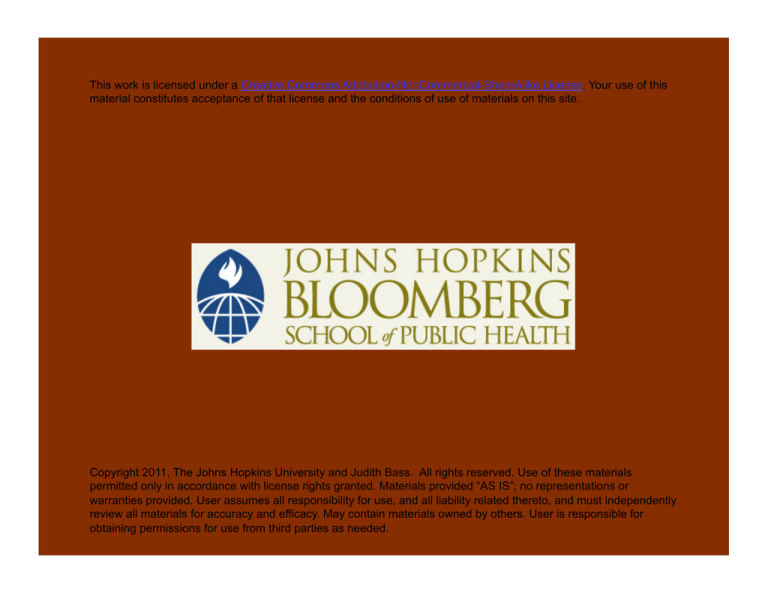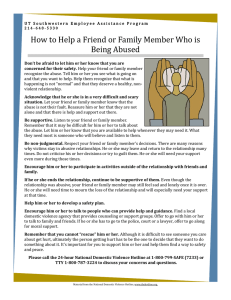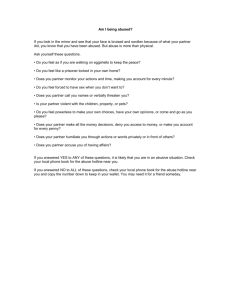
This work is licensed under a Creative Commons Attribution-NonCommercial-ShareAlike License. Your use of this
material constitutes acceptance of that license and the conditions of use of materials on this site.
Copyright 2011, The Johns Hopkins University and Judith Bass. All rights reserved. Use of these materials
permitted only in accordance with license rights granted. Materials provided “AS IS”; no representations or
warranties provided. User assumes all responsibility for use, and all liability related thereto, and must independently
review all materials for accuracy and efficacy. May contain materials owned by others. User is responsible for
obtaining permissions for use from third parties as needed.
Section B
Qualitative Research on Street Children
Definitions
Children of the street
- Boys and girls who have no adult supervision and have made the
street their “home”
Children in the street
- Boys and girls who spend a substantial portion of their time
working in the street environment
Children at high risk
- Boys and girls who live in poverty and are at risk of migrating to
the street
3
Qualitative Study for Street Children in Mexico City
Describe the problems experienced
by street children
Discover the problems that caused
them to go to the street
Define the activities that they feel
are important and want to improve
Photo by ashabot. Creative Commons BY-NC-SA. Retrieved from
http://www.flickr.com/photos/ashabot/3256359591/sizes/m/
4
Results: Free Lists
Major problems
- Violence—among children, by police or authorities, at home,
including sexual exploitation
-
-
-
-
Family problems
Drug abuse and addiction
Poverty and exposure to illnesses
Humiliation and discrimination from people other than the
authorities
5
Results: Key Informants
Family problems
- Disputes or mistreatment at home resulting in either leaving
home or being thrown out
-
-
-
Physical, sexual, and mental abuse by parents and their
partners and by other relatives
Rape and drugs among family members
Lack of affection, attention, or care by parents
6
Results: Key Informants
Good things about being on the streets
- Freedom to go wherever
-
Street has its own rules, but not restrictions compared with
home
-
Better treatment of each other on the streets, children
supporting each other, sharing, people who can provide advice
-
-
Drugs—they help children to forget problems
People/organizations give food and money and take you to
shelters or centers
7
Results: Key Informants
Bad things about being on the street
- Drugs, physical, and mental abuse—police lock children away on
spurious charges
-
Abuse, rejection, discrimination, and exploitation by society—
while begging, being offered demeaning odd jobs with very
little pay and accompanying humiliation
-
The street is dangerous—violence, fighting, rape (pregnancy),
and death (suicide)
Lack of food, clothes, and shelter
-
-
Children become aggressive, low self-esteem, false friendships
8
Results: Key Informants
Humiliation and other emotions
- People humiliate them for food and money
-
-
-
-
-
-
People criticize them/make fun of them
Children humiliate each other
Feel sad, rejected, abandoned, anger, hatred, depression/
desperation
People don’t understand them/consider them worthless
Humiliation causes children to retaliate/be aggressive against
each other and outsiders
Drugs to escape/forget emotions and problems
9
Albania Study Results
Child exploitation
- By their parents who force them to stay all day in the street,
risk of being sexually exploited
Psychological and physical abuse/violence
- Being insulted and sworn at and beaten by parents, other
adults, peers, and sometimes by teachers, other beggars, or
police
Risky behaviors and delinquency
-
Drugs, gambling money, stealing and fighting between children
Emotional problems
- Fear connected to the dangers of street life, shame and guilt,
sadness and feelings of suffering
10
Myanmar Study Results
Consequences of being on the street
- Discrimination by others and peers
-
-
-
Injuries from hard labor
Beatings by business owners and other adults
Always tired
Mental health and psychosocial problems
- Sadness, fear, inferiority, shame, hate, worry, bored, feel not
loved, jealousy, lack of confidence
Coping mechanisms
- Run away, drink alcohol, waste time with friends, sleep/lie in
bed, fight
11







